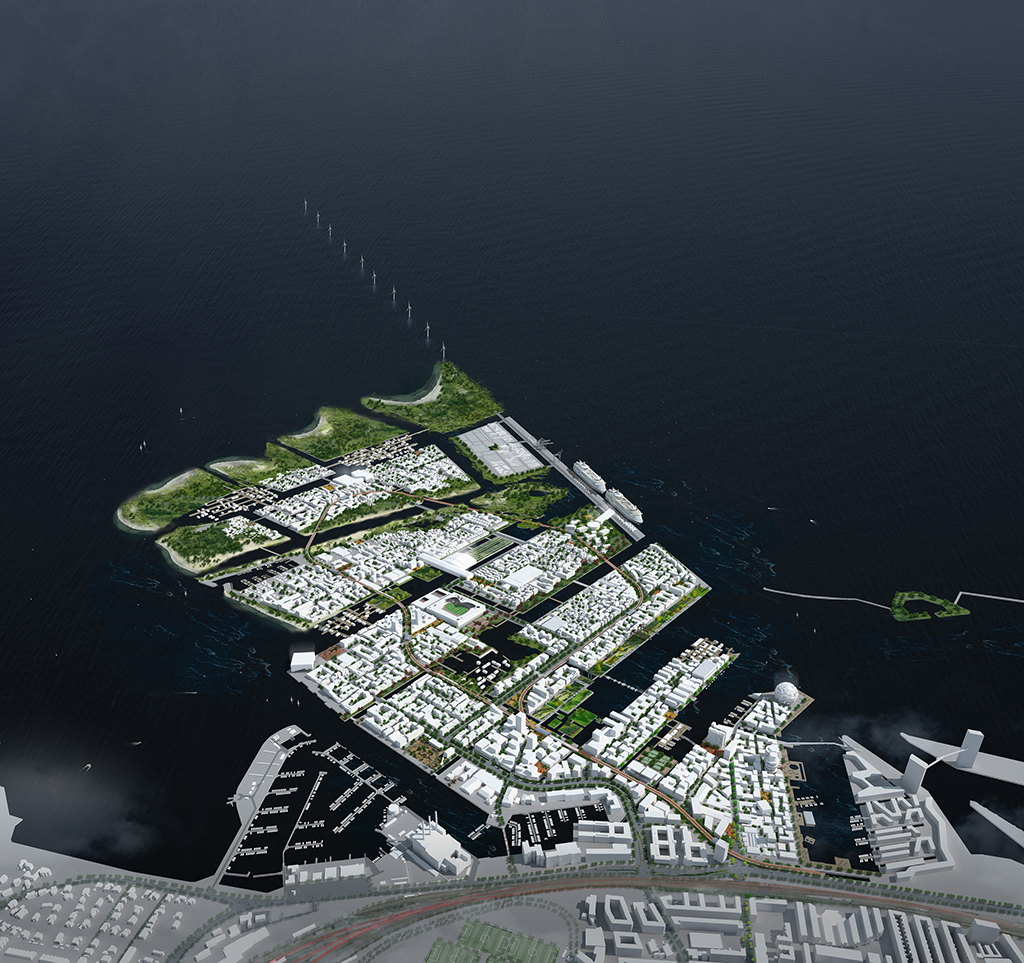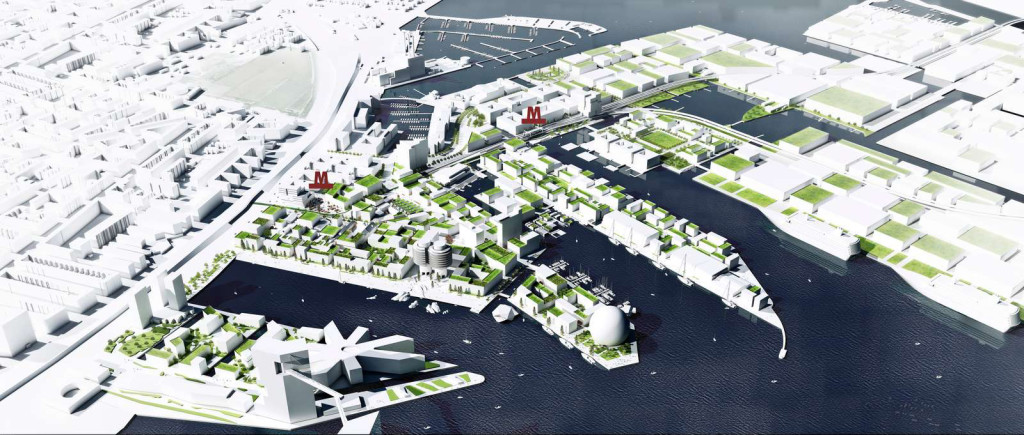Since 2009 CPH City & Port Development has been working closely with a team of consultants, Cobe, Sleth, Polyform and Rambøll, on the development of Nordhavn (the North Harbour) into a city district. The team of consultants won the international ideas competition for the Nordhavn that CPH City & Port launched in 2008.
The Nordhavn Project is the newest part of a successful recent transformation of Copenhagen into a city of knowledge. From the start of the 1990s until today it can be put down to the broad political consensus on the fact that Copenhagen had to be rejuvenated and that a strong capital city would positively impact the rest of the country. The number of inhabitants has since then increased from 450.000 to 600.000 and is expected to grow to 700.000 by 2027.
Nordhavn is a 200 ha former harbour industrial area, which isn’t needed any longer.
From idea to strategy
The urban strategy for Nordhavn is that it will be a district of small islets close to the waterfront and a diverse mixed city with room for everyone. It will be a sustainable city of 3 million square metres of floor area – the Copenhagen way.
The history of Nordhavn is the basis for the development of the new district. The traces of history provide a great potential for creating a new district with an identity of its own.
The strategy is based on a holistic approach with six themes:
- Islets and canals
- Identity and history
- Five-minutes city
- Blue and green city
- CO2 friendly city
- Staggered building zone structure
The ambition of CPH City & Port Development is to make Nordhavn an urban neighbourhood where people enjoy living and working so much that once they’ve moved in, they don’t want to leave.
Structure plan of Nordhavn, 2008. (Source: COBE, SLETH, Polyform and Ramb+©ll)
From strategy to realisation
The development has started in areas located closest to the existing city of Copenhagen.
In recent years Nordhavn has become an exciting area of contrast as new urban neighbourhoods encroach on the raw character of the harbour and where you can see the past and the present co-exist.
Water is a huge bonus for any urban area. In this neighbourhood, it is a given as the area is bordered by piers jutting out into the open water meaning there is a maximum of a few hundred metres to the water from wherever you are. By connecting the large harbour basins with smaller canals we have established a network of waterways – one of the distinguishing features of Nordhavn.
Currently in mid 2016, around 200,000 square metres of floor area in the first section – the Århusgade neighbourhood – are under construction. The neighbourhood’s remaining 150,000 square metres of floor area are expected to be build within the next few years. Both developers and end users have shown enormous interest in Nordhavn making it a huge success.
Seven hundred residents have moved to the Århusgade neighbourhood by now and within a year it will be three thousands.
The Masterplan for Inner Nordhavn sets out consistently dense and compact urban neighbourhoods where blocks of varying height and architectonic expression define the streets and snug urban spaces. In the Århusgade neighbourhood you can already sense that this is going to be a liveable neighbourhood with experiences waiting to be explored, inviting urban spaces and strict architectural lines.
Visualisation of Inner Nordhavn.
The small scale is the reason for the area’s success yet at the same time this is what creates the biggest challenge. Because although you can’t see it, what takes place above ground has a large impact on what happens underground. Narrow streets and alleys, trees and plants and not least canals all need to be taken into consideration, which doesn’t leave much room for supply networks.
The streets and roads are designed to function both for traffic and as places to spend time. The outer edge zones are designed with tables, benches, flower pots, trees, planted borders, street lighting, places to spend time and paving that all need to work with normal traffic and in particular allow for emergency service access.
It is our ambition to kickstart the Århusgade neighbourhood and make it a liveable city quarter from the start. To do that we work with contrasts in density, we mix new and old, we mix high and low, we mix open promenades and public spaces defines by closed blocks.
Former silos and warehouses have been refurbished into housing and office buildings and provide a certain character to the area.
So do the first parking garage in red concrete and corten steel with a supermarket and a recycle plant at the ground floor and a public exercise and play ground at the roof.
In the spring 2017 a huge wooden deck with recreational activities will be completed and the first shops and restaurants out of in all 10.000 square metres will open.
In 2020 opens metro with two stations, which are under construction.
If you are visiting the Århusgade neighbourhood of Nordhavn in 2016 I’d recommend a walk down one of the local streets where you get a good sense of the density and compactness of this area.
Climb up to the rooftop activity area on top of the red multi-storey car park via one of the outdoor staircases and you can see Nordhavn’s history in the frieze on the wall of the stairwell. At the top you might want to climb the climbing pyramid or simply enjoy the amazing view of the neighbourhood towards the historic old city and out over Oresund.
Aerial photo of Århusgade neighbourhood, 2016.
The next steps
The development work in Nordhavn is going to continue in the adjacent neighbourhoods – one step at a time. Some of these steps will be short, some long and some faster than others. And there will also be breaks where development takes place at a slower pace. Our experience is that development happens in waves.
In a few years, we will start the next phase of the urban development of Nordhavn. The overall structural plan for the entire area of Nordhavn outlines the division of the area into smaller neighbourhoods, each with its own characteristic identity. The concept of the five-minute city is now ingrained in the DNA of Nordhavn.
The five-minute city refers to the fact that everything needed in daily life is just a short distance away – not least public transport in the form of the metro. Therefore the metro line will be extended with another two stations and a new motor access will be build.
The structural plan has also defined green recreational areas that need to be larger and more attractive as development stretches further and further out into Nordhavn. Therefore, in the coming phase we will be focusing on the green elements of the city because we appreciate the importance of nature when people choose somewhere to live.
We will retain the concept of a dense city on a human scale, in part because it suits our climate with its strong wind and relatively low-lying sun.
The development of Nordhavn will take many decades. During this period, new conditions for development will emerge. It’s difficult to predict whether these future changes will be demographic, societal, technological or lifestyle-related, which is why planning needs to have the necessary robustness and flexibility to be able to adapt.
That is why it is important that the large defining elements available in the neighbourhood are specified. In particular, infrastructure is key for creating links between the different neighbourhoods of Nordhavn and between Nordhavn and the rest of Copenhagen. The structural plan from 2008 gives us a good starting point to achieve this.
References
The Competition Brief
© CPH City & Port Development, May 2008
The Jury Report
© CPH City & Port Development, December 2008
Urban Strategy
© CPH City & Port Development, November 2009
Inner Nordhavn – From Idea to Project
© CPH City & Port Development, August 2012
Head image: Aerial photo of Nordhavn, 2016.


